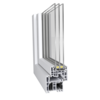EnEV: Buildings to be constructed are to be designed in such a way that the maximum levels of transmission heat loss stipulated by the applicable EnEV (German Energy Saving Ordinance) are not exceeded. However, an upper limit for windows has not been defined specifically. Nevertheless, a U value (thermal transfer coefficient) of 1.3 W/m²K for windows as presented by the reference building described in EnEV has established itself as maximum.
KfW: The German KfW development bank with its loan programs strives for an even higher level of energy efficiency than stipulated by the applicable EnEV. For buildings to be constructed that comply with KfW requirements, certain funding, e.g. by low-interest loans, is possible. Basically, these loan programmes have replaced former state subsidy for owner-occupied homes and demand for KfW funding is rising constantly (see www.KFW.de).
Passive house: Passive houses are buildings that can do without conventional heating; they are heated passively by solar energy entering e.g. through large windows especially on the building’s south side. Windows on the north side are either small or there are no windows at all to minimize heat loss. Solar gains on this side of the building are usually negligible. There are different regulations for the construction of window elements for passive houses that apply. KfW for example only requires a maximum Uw value of 0.8 W/m²K to grant funding, while the Passivhaus Institut Dr. Feist lays down requirements on single components, which generally increases the price of window elements. The German institute for window technology ift recently published a guideline for passive house windows requiring nearly the mean value of the above mentioned and by this means presents a reasonable benchmark for future constructions. Window fabricators should pay close attention to the requirements stipulated in the invitation to tender as the building components must meet these specific requirements regardless of other standards that might be met.
Zero-energy house: These houses consume even less energy than passive houses; under normal use, they consume at most as much energy as they produce.
Energy-plus house: Above all, manufacturers of prefabricated houses offer energy-plus buildings that produce even more energy than they consume under normal usage. The extra energy can for example be fed into the power grid. In terms of thermal insulation, the construction of this type of building is based on the passive house principle. Additionally, it is provided with sophisticated technologies (photovoltaic systems etc.) to generate electricity.

 Argentina | español
Argentina | español Bosna i Hercegovina
Bosna i Hercegovina Česká republika | czech
Česká republika | czech China | 中文
China | 中文 España | español
España | español France | français
France | français Hrvatska | hrvatski
Hrvatska | hrvatski Indonesia | english
Indonesia | english International | english
International | english  Italia | italiano
Italia | italiano Kosovës
Kosovës Magyarország | magyar
Magyarország | magyar México | español
México | español Nederland | nederlands
Nederland | nederlands Österreich | deutsch
Österreich | deutsch Slovensko | slovenský
Slovensko | slovenský Srbija | srpski
Srbija | srpski Ukrayina | українська
Ukrayina | українська







